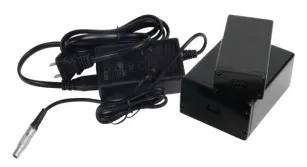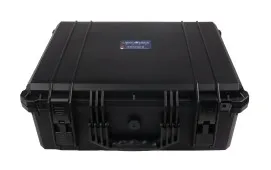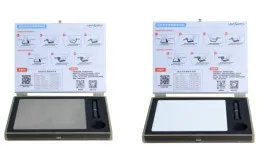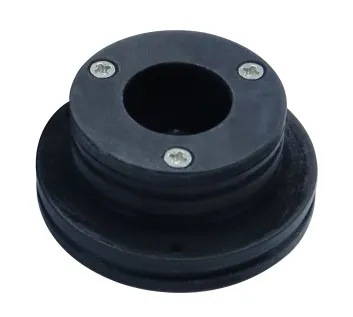Focus on spectral sensing and optoelectronic application systems
Handheld Infrared Field Spectroradiometer
The iSpecField-NIR-HH handheld infrared field spectrometer, developed by LiSen Optics, is specifically designed for field remote sensing and environmental monitoring. It operates based on the principles of infrared spectroscopy, measuring the reflection, absorption, or emission characteristics of substances within the infrared spectrum to identify and quantify their types and properties. This spectrometer features a broad wavelength range from 300-1700nm, covering visible light, near-infrared, and shortwave infrared regions. This enables comprehensive spectral analysis of substances by measuring their reflection, absorption, and emission properties across different spectral regions.
The iSpecField-NIR-HH handheld infrared field spectrometer, developed by LiSen Optics, is specifically designed for field remote sensing and environmental monitoring. It operates based on the principles of infrared spectroscopy, measuring the reflection, absorption, or emission characteristics of substances within the infrared spectrum to identify and quantify their types and properties. This spectrometer features a broad wavelength range from 300-1700nm, covering visible light, near-infrared, and shortwave infrared regions. This enables comprehensive spectral analysis of substances by measuring their reflection, absorption, and emission properties across different spectral regions.
Product Introduction
Typical Applications
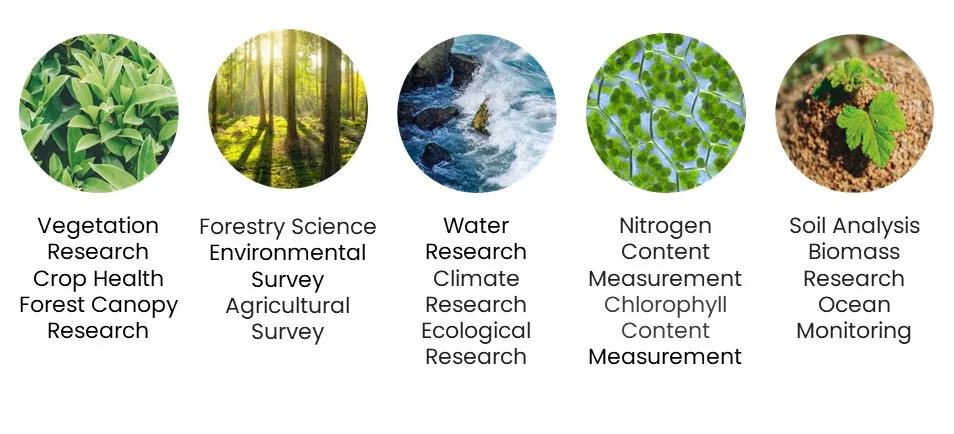
Technical Advantages
|
● Advanced Detector Technology: The spectrometer incorporates a 1024-pixel CMOS detector for the visible and near-infrared regions, and a 256-pixel InGaAs detector for shortwave infrared measurements. ● Fixed Holographic Grating Scanning: Ensures stability and consistency in spectral measurements. ● Wide Wavelength Range: 300-1700nm, providing high precision and resolution. |
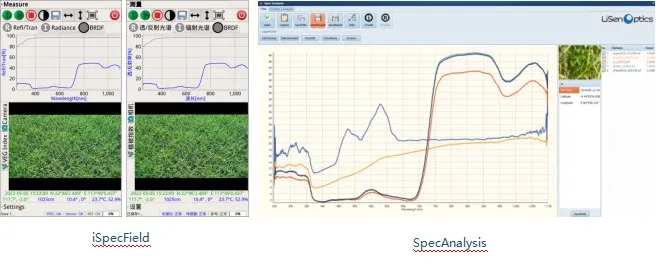 |
● High Spectral Resolution: ≤3nm @300-1100nm and ≤6nm @900-1700nm.
● Short Integration Time: Minimum integration time of 30 microseconds, accommodating a wide dynamic range.
● High-Definition Touchscreen: 4.3-inch HD touchscreen display.
● Real-Time Vegetation Index Display: Supports multiple vegetation indices such as NDVI, DVI, EVI, CARI, PRI, RDVI, RVI, SAVI, SIPI, TVI, WI, VARI_700, and VARI_green.
● SpecAnalysis Software: For post-processing and analysis of spectral data, compatible with ENVI format, integrated with the USGS database and 41 vegetation indices.
● Portable and Lightweight: Weighs less than 2 kg, with flexible operation and a battery life of ≥5 hours.
Typical Applications

Technical Advantages
|
● Advanced Detector Technology: The spectrometer incorporates a 1024-pixel CMOS detector for the visible and near-infrared regions, and a 256-pixel InGaAs detector for shortwave infrared measurements. ● Fixed Holographic Grating Scanning: Ensures stability and consistency in spectral measurements. ● Wide Wavelength Range: 300-1700nm, providing high precision and resolution. |
 |
● High Spectral Resolution: ≤3nm @300-1100nm and ≤6nm @900-1700nm.
● Short Integration Time: Minimum integration time of 30 microseconds, accommodating a wide dynamic range.
● High-Definition Touchscreen: 4.3-inch HD touchscreen display.
● Real-Time Vegetation Index Display: Supports multiple vegetation indices such as NDVI, DVI, EVI, CARI, PRI, RDVI, RVI, SAVI, SIPI, TVI, WI, VARI_700, and VARI_green.
● SpecAnalysis Software: For post-processing and analysis of spectral data, compatible with ENVI format, integrated with the USGS database and 41 vegetation indices.
● Portable and Lightweight: Weighs less than 2 kg, with flexible operation and a battery life of ≥5 hours.
![]() Main Technical Indicators
Main Technical Indicators
|
Model |
iSpecField-NIR-HH |
|
Wavelength Range |
300-1700nm |
|
Wavelength Accuracy |
≤±0.3nm |
|
Wavelength Repeatability |
± 0.1nm |
|
Spectral Resolution |
≤3nm @300-1100nm; ≤6nm @900-1700nm |
|
Spectral Wavelength Sampling Interval |
2.5nm @300-1100nm; 3nm @1100-1700nm |
|
Number of Spectral Channels |
585 |
|
Equivalent Noise Radiance |
1.0×10^-8 W/cm²/nm/sr @700nm; 8.0×10^-8 W/cm²/nm/sr @1500nm |
|
Detector |
1024-pixel CMOS / 256-pixel InGaAs |
|
Scanning Method |
Fixed holographic grating |
|
Minimum Integration Exposure Time |
≥30μs |
|
Memory |
32GB |
|
Real-Time Vegetation Index Display |
YES |
|
Shutter Control |
Manual light source switch |
|
Data Acquisition |
PDA touch display |
|
Touchscreen Size |
4.3 inches |
|
Data Download |
Type-C |
|
Spectral Software |
iSpecField spectral measurement acquisition software (screen end), |
|
SpecAnalysis post-processing analysis software |
|
|
Battery Life |
≥5 hours (removable) |
![]() Main Technical Indicators
Main Technical Indicators
|
Model |
iSpecField-NIR-HH |
|
Wavelength Range |
300-1700nm |
|
Wavelength Accuracy |
≤±0.3nm |
|
Wavelength Repeatability |
± 0.1nm |
|
Spectral Resolution |
≤3nm @300-1100nm; ≤6nm @900-1700nm |
|
Spectral Wavelength Sampling Interval |
2.5nm @300-1100nm; 3nm @1100-1700nm |
|
Number of Spectral Channels |
585 |
|
Equivalent Noise Radiance |
1.0×10^-8 W/cm²/nm/sr @700nm; 8.0×10^-8 W/cm²/nm/sr @1500nm |
|
Detector |
1024-pixel CMOS / 256-pixel InGaAs |
|
Scanning Method |
Fixed holographic grating |
|
Minimum Integration Exposure Time |
≥30μs |
|
Memory |
32GB |
|
Real-Time Vegetation Index Display |
YES |
|
Shutter Control |
Manual light source switch |
|
Data Acquisition |
PDA touch display |
|
Touchscreen Size |
4.3 inches |
|
Data Download |
Type-C |
|
Spectral Software |
iSpecField spectral measurement acquisition software (screen end), |
|
SpecAnalysis post-processing analysis software |
|
|
Battery Life |
≥5 hours (removable) |
Optical Accessories
|
● Spare Battery and Charger 6400mAh capacity, 11.1V voltage, ≥5 hours endurance |
|
|
● Portable Outdoor Instrument Case Dimensions: 42cm (length) × 34cm (width) × 18cm (height) |
|
|
● Diffuse Reflectance Standard Panels 1. Range: 250-2500nm 2. Reflectance: 3%/5%/10%/20%/30%/40%/50%/≥98% 3. Size: 185×165mm / 250×250mm
|
|
|
● Diffuse Reflectance Standard Black Panel 1. Size: φ20mm 2. Reflectance: <3% 3. Spectral range: 350-2500nm |
|
Optical Accessories
|
● Spare Battery and Charger 6400mAh capacity, 11.1V voltage, ≥5 hours endurance |
|
|
● Portable Outdoor Instrument Case Dimensions: 42cm (length) × 34cm (width) × 18cm (height) |
|
|
● Diffuse Reflectance Standard Panels 1. Range: 250-2500nm 2. Reflectance: 3%/5%/10%/20%/30%/40%/50%/≥98% 3. Size: 185×165mm / 250×250mm
|
|
|
● Diffuse Reflectance Standard Black Panel 1. Size: φ20mm 2. Reflectance: <3% 3. Spectral range: 350-2500nm |
|
Application in Agriculture and Forestry
Vegetation serves as a significant domain of application in the field of optoelectronics, particularly in remote sensing. The utilization of remote sensing in the vegetation analysis primarily revolves around the determination of vegetation distribution, classification, and growth patterns. Different plant species exhibit distinctive spectral signatures due to variations in their structural composition and chlorophyll content, with notable discrepancies observed in the near-infrared spectral range. Spectral imaging techniques can effectively discern between various types of vegetation, such as deciduous and evergreen trees, by capitalizing on the phenological differences during different seasons. Additionally, alterations in the vegetation structure and chlorophyll content resulting from factors like diseases and pest infestations manifest prominently in the near-infrared range, presenting discernible deviations from healthy vegetation. Prominent factors influencing the spectral characteristics of vegetation encompass the botanical taxonomy, seasonal dynamics, and the influences exerted by pests and diseases. n
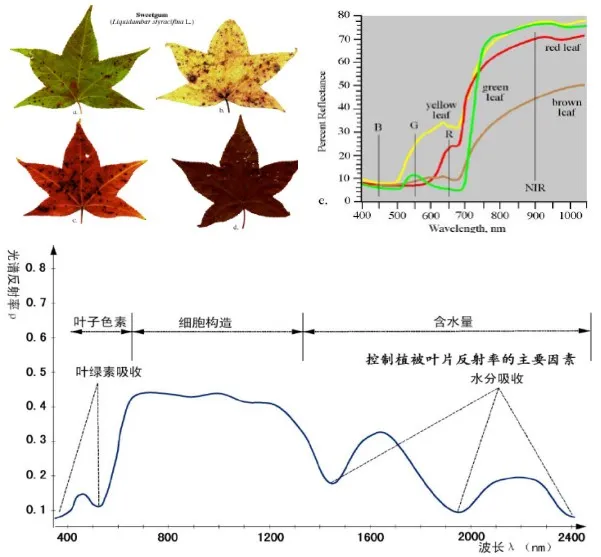 The key spectral features of vegetation can be summarized as follows in the field of optoelectronics: In the visible light range of 0.4 to 0.76 μm, a distinct reflection peak is observed, typically with reflectance ranging from 10% to 20%, centered around 0.55 μm (green). Additionally, there are two absorption bands flanking this peak at approximately 0.45 μm (blue) and 0.67 μm (red). Moving into the near-infrared range of 0.7 to 0.8 μm, a significant increase in reflectance occurs, characterized by a steep slope. Near 1.1 μm, another notable peak is observed, representing a unique spectral feature specific to vegetation. Transitioning to the mid-infrared range of 1.3 to 2.5 μm, the presence of water content in plants becomes a prominent factor. As a result, there is a substantial increase in absorption and a corresponding decrease in reflectance. Three distinct absorption valleys are evident near 1.4 μm, 1.9 μm, and 2.6 to 2.7 μm, primarily governed by the absorption properties of water within the cellular structure of leaves. The influencing factors in this absorption phenomenon encompass leaf thickness and water content.
The key spectral features of vegetation can be summarized as follows in the field of optoelectronics: In the visible light range of 0.4 to 0.76 μm, a distinct reflection peak is observed, typically with reflectance ranging from 10% to 20%, centered around 0.55 μm (green). Additionally, there are two absorption bands flanking this peak at approximately 0.45 μm (blue) and 0.67 μm (red). Moving into the near-infrared range of 0.7 to 0.8 μm, a significant increase in reflectance occurs, characterized by a steep slope. Near 1.1 μm, another notable peak is observed, representing a unique spectral feature specific to vegetation. Transitioning to the mid-infrared range of 1.3 to 2.5 μm, the presence of water content in plants becomes a prominent factor. As a result, there is a substantial increase in absorption and a corresponding decrease in reflectance. Three distinct absorption valleys are evident near 1.4 μm, 1.9 μm, and 2.6 to 2.7 μm, primarily governed by the absorption properties of water within the cellular structure of leaves. The influencing factors in this absorption phenomenon encompass leaf thickness and water content.
Application in Ecological Environment
Soil remote sensing, within the field of optoelectronics, focuses on utilizing the spectral characteristics of soil to identify and classify different soil types, analyze the spatial distribution patterns of soil, and provide a scientific foundation for the rational development, utilization, management, and conservation of soil resources. By preventing the soil quality degradation and quantity reduction, it aims at improving soil conditions and facilitate the sustainable utilization of soil resources, fostering advancements in soil remote sensing science.
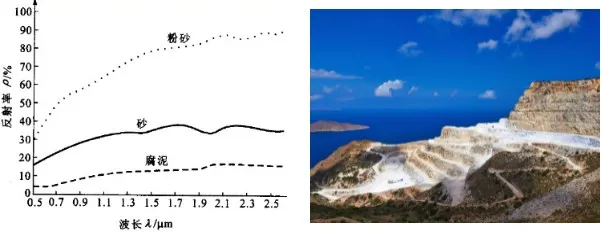
Under natural conditions, the reflectance spectrum of the soil surface exhibits a relatively smooth profile without prominent peaks or valleys. Generally, soils with finer particles tend to have higher reflectance values. The reflectance of soil is influenced by factors such as the organic matter content, moisture content, soil composition, and fertility. However, due to the smooth spectral curve, the differentiation of soil brightness on remote sensing images across various spectral bands may not be readily apparent.
Multiple factors contribute to variations in the spectral characteristics of soil, including the primary minerals, secondary minerals, soil moisture content, organic matter content, soil texture, and particle size. The main spectral features of soil are as follows: In its natural state, the reflectance curve of the soil surface lacks distinct peaks and absorption valleys, appearing relatively smooth. Under dry conditions, the spectral properties of soil primarily relate to the presence of primary minerals, secondary minerals, and organic matter.
As the soil moisture content increases, the reflectance of soil decreases, particularly in the vicinity of water absorption bands (around 1.4 μm, 1.9 μm, and 2.7 μm), where the decrease is particularly pronounced. Soil minerals, including quartz, mica, feldspar, oxides, among others, contribute to the differentiation of soil characteristics through the analysis of corresponding mineral contents. Additionally, the size and proportion of soil particles serves as indicators of particle size and water retention capacity.
Application in Mineral Exploration
Surface rocks are generally classified into three major categories: sedimentary rocks, volcanic rocks, and metamorphic rocks. The reflectance spectra of several rocks are shown in the figure below. The spectral nature of surface rock is essentially a mixed spectrum of minerals, and its spectral characteristics are influenced by factors such as the composition, structure, texture, and surface condition. Therefore, the identification of minerals through the reflectance spectra of surface minerals can achieve the goal of determining the type of rock.
The reflectance spectrum of rocks is primarily determined by the mineral composition, content, and material structure. Prominent absorption peaks are commonly observed in surface rocks, including hydroxyl-bearing minerals (2.10-2.40 μm), crystalline water minerals (1.40 μm, 2.40 μm), carbonate minerals (1.90 μm, 2.35 μm, 2.5 μm), and iron minerals (0.5 μm, 1.1 μm), among others. For example, the spectral characteristics of rocks in the 3-5 μm wavelength range are determined by the vibrational modes of molecular bonds such as oxygen-silicon and oxygen-aluminum. In addition to material composition, environmental conditions, surface characteristics of rocks and minerals, and physical weathering can also cause variations in the reflectance spectra of rocks, such as changes in reflectance values, positions, widths, absorption depths, and shapes of spectral bands.
Spectral instruments used for remote sensing require low energy and provide rapid analysis within a few seconds. They do not require any chemical reagents and pose no harm to human health. By acquiring spectral reflectance data, they can be utilized for the study of gemstone materials. The high spectral resolution can accurately reveal the information of harmonic and combination frequencies of molecular vibrations in gemstones, allowing for the analysis of complex structural information related to chemical bond interactions. Therefore, the high spectral resolution has significant potential in the gemstone analysis.
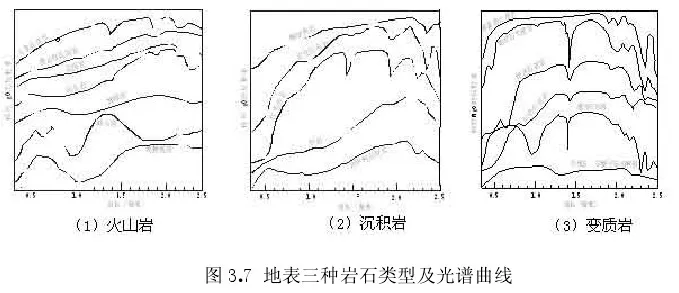 Application in Aquatic Environmental Oceanography
Application in Aquatic Environmental Oceanography
Ocean remote sensing has a broad coverage area and offers the advantages of simultaneity, allowing for continuous, long-term, and rapid observations of the ocean. It provides a comprehensive depiction of oceanic features, including sea surface temperature, oceanic currents, water distribution, waves, coastal sediment plumes, as well as phenomena such as red tides and oil spills. Ocean remote sensing is primarily applied in the investigation and monitoring of large-scale ocean circulation, nearshore surface flow fields, harbor water quality, marine surface chlorophyll concentration, and other aspects related to oceanography, meteorology, biology, physics, marine dynamics, marine pollution, and nearshore engineering.
Ocean remote sensing can be classified into three modalities: space-based remote sensing, airborne remote sensing, and ground-based remote sensing. Remote sensing methods can be divided into two types: active remote sensing, where electromagnetic waves are emitted from sensors to the ocean surface and the returning signals are used to extract oceanic information or images; and passive remote sensing, where sensors only receive the thermal radiation or scattered solar and sky radiance from the ocean surface to retrieve oceanic information or images.
Chlorophyll-a and total suspended matter are two important substances that influence the color of seawater and reflect changes in ocean water quality, making them crucial indicators for marine environmental monitoring. The reflectance of water is generally low, usually less than 10%, much lower than most other terrestrial objects. Water exhibits strong reflectance in the blue-green spectrum, while it absorbs strongly in other visible light spectra. The reflectance spectrum of pure water shows a peak in the blue region, which decreases gradually with increasing wavelength. In the near-infrared region, the reflectance of water is close to zero. However, in the presence of chlorophyll, the reflectance spectrum of clear water exhibits a peak in the green spectrum, and the height of the peak increases with the concentration of chlorophyll. This characteristic can be used to monitor and estimate algal biomass. Conversely, turbid water and sediment-laden water have higher reflectance than pure water, with reflectance peaks appearing in the yellow-red region.
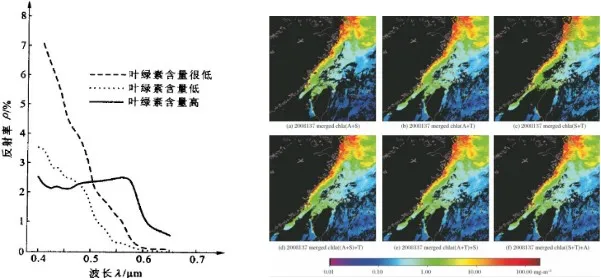
Application in Agriculture and Forestry
Vegetation serves as a significant domain of application in the field of optoelectronics, particularly in remote sensing. The utilization of remote sensing in the vegetation analysis primarily revolves around the determination of vegetation distribution, classification, and growth patterns. Different plant species exhibit distinctive spectral signatures due to variations in their structural composition and chlorophyll content, with notable discrepancies observed in the near-infrared spectral range. Spectral imaging techniques can effectively discern between various types of vegetation, such as deciduous and evergreen trees, by capitalizing on the phenological differences during different seasons. Additionally, alterations in the vegetation structure and chlorophyll content resulting from factors like diseases and pest infestations manifest prominently in the near-infrared range, presenting discernible deviations from healthy vegetation. Prominent factors influencing the spectral characteristics of vegetation encompass the botanical taxonomy, seasonal dynamics, and the influences exerted by pests and diseases. n
 The key spectral features of vegetation can be summarized as follows in the field of optoelectronics: In the visible light range of 0.4 to 0.76 μm, a distinct reflection peak is observed, typically with reflectance ranging from 10% to 20%, centered around 0.55 μm (green). Additionally, there are two absorption bands flanking this peak at approximately 0.45 μm (blue) and 0.67 μm (red). Moving into the near-infrared range of 0.7 to 0.8 μm, a significant increase in reflectance occurs, characterized by a steep slope. Near 1.1 μm, another notable peak is observed, representing a unique spectral feature specific to vegetation. Transitioning to the mid-infrared range of 1.3 to 2.5 μm, the presence of water content in plants becomes a prominent factor. As a result, there is a substantial increase in absorption and a corresponding decrease in reflectance. Three distinct absorption valleys are evident near 1.4 μm, 1.9 μm, and 2.6 to 2.7 μm, primarily governed by the absorption properties of water within the cellular structure of leaves. The influencing factors in this absorption phenomenon encompass leaf thickness and water content.
The key spectral features of vegetation can be summarized as follows in the field of optoelectronics: In the visible light range of 0.4 to 0.76 μm, a distinct reflection peak is observed, typically with reflectance ranging from 10% to 20%, centered around 0.55 μm (green). Additionally, there are two absorption bands flanking this peak at approximately 0.45 μm (blue) and 0.67 μm (red). Moving into the near-infrared range of 0.7 to 0.8 μm, a significant increase in reflectance occurs, characterized by a steep slope. Near 1.1 μm, another notable peak is observed, representing a unique spectral feature specific to vegetation. Transitioning to the mid-infrared range of 1.3 to 2.5 μm, the presence of water content in plants becomes a prominent factor. As a result, there is a substantial increase in absorption and a corresponding decrease in reflectance. Three distinct absorption valleys are evident near 1.4 μm, 1.9 μm, and 2.6 to 2.7 μm, primarily governed by the absorption properties of water within the cellular structure of leaves. The influencing factors in this absorption phenomenon encompass leaf thickness and water content.
Application in Ecological Environment
Soil remote sensing, within the field of optoelectronics, focuses on utilizing the spectral characteristics of soil to identify and classify different soil types, analyze the spatial distribution patterns of soil, and provide a scientific foundation for the rational development, utilization, management, and conservation of soil resources. By preventing the soil quality degradation and quantity reduction, it aims at improving soil conditions and facilitate the sustainable utilization of soil resources, fostering advancements in soil remote sensing science.

Under natural conditions, the reflectance spectrum of the soil surface exhibits a relatively smooth profile without prominent peaks or valleys. Generally, soils with finer particles tend to have higher reflectance values. The reflectance of soil is influenced by factors such as the organic matter content, moisture content, soil composition, and fertility. However, due to the smooth spectral curve, the differentiation of soil brightness on remote sensing images across various spectral bands may not be readily apparent.
Multiple factors contribute to variations in the spectral characteristics of soil, including the primary minerals, secondary minerals, soil moisture content, organic matter content, soil texture, and particle size. The main spectral features of soil are as follows: In its natural state, the reflectance curve of the soil surface lacks distinct peaks and absorption valleys, appearing relatively smooth. Under dry conditions, the spectral properties of soil primarily relate to the presence of primary minerals, secondary minerals, and organic matter.
As the soil moisture content increases, the reflectance of soil decreases, particularly in the vicinity of water absorption bands (around 1.4 μm, 1.9 μm, and 2.7 μm), where the decrease is particularly pronounced. Soil minerals, including quartz, mica, feldspar, oxides, among others, contribute to the differentiation of soil characteristics through the analysis of corresponding mineral contents. Additionally, the size and proportion of soil particles serves as indicators of particle size and water retention capacity.
Application in Mineral Exploration
Surface rocks are generally classified into three major categories: sedimentary rocks, volcanic rocks, and metamorphic rocks. The reflectance spectra of several rocks are shown in the figure below. The spectral nature of surface rock is essentially a mixed spectrum of minerals, and its spectral characteristics are influenced by factors such as the composition, structure, texture, and surface condition. Therefore, the identification of minerals through the reflectance spectra of surface minerals can achieve the goal of determining the type of rock.
The reflectance spectrum of rocks is primarily determined by the mineral composition, content, and material structure. Prominent absorption peaks are commonly observed in surface rocks, including hydroxyl-bearing minerals (2.10-2.40 μm), crystalline water minerals (1.40 μm, 2.40 μm), carbonate minerals (1.90 μm, 2.35 μm, 2.5 μm), and iron minerals (0.5 μm, 1.1 μm), among others. For example, the spectral characteristics of rocks in the 3-5 μm wavelength range are determined by the vibrational modes of molecular bonds such as oxygen-silicon and oxygen-aluminum. In addition to material composition, environmental conditions, surface characteristics of rocks and minerals, and physical weathering can also cause variations in the reflectance spectra of rocks, such as changes in reflectance values, positions, widths, absorption depths, and shapes of spectral bands.
Spectral instruments used for remote sensing require low energy and provide rapid analysis within a few seconds. They do not require any chemical reagents and pose no harm to human health. By acquiring spectral reflectance data, they can be utilized for the study of gemstone materials. The high spectral resolution can accurately reveal the information of harmonic and combination frequencies of molecular vibrations in gemstones, allowing for the analysis of complex structural information related to chemical bond interactions. Therefore, the high spectral resolution has significant potential in the gemstone analysis.
 Application in Aquatic Environmental Oceanography
Application in Aquatic Environmental Oceanography
Ocean remote sensing has a broad coverage area and offers the advantages of simultaneity, allowing for continuous, long-term, and rapid observations of the ocean. It provides a comprehensive depiction of oceanic features, including sea surface temperature, oceanic currents, water distribution, waves, coastal sediment plumes, as well as phenomena such as red tides and oil spills. Ocean remote sensing is primarily applied in the investigation and monitoring of large-scale ocean circulation, nearshore surface flow fields, harbor water quality, marine surface chlorophyll concentration, and other aspects related to oceanography, meteorology, biology, physics, marine dynamics, marine pollution, and nearshore engineering.
Ocean remote sensing can be classified into three modalities: space-based remote sensing, airborne remote sensing, and ground-based remote sensing. Remote sensing methods can be divided into two types: active remote sensing, where electromagnetic waves are emitted from sensors to the ocean surface and the returning signals are used to extract oceanic information or images; and passive remote sensing, where sensors only receive the thermal radiation or scattered solar and sky radiance from the ocean surface to retrieve oceanic information or images.
Chlorophyll-a and total suspended matter are two important substances that influence the color of seawater and reflect changes in ocean water quality, making them crucial indicators for marine environmental monitoring. The reflectance of water is generally low, usually less than 10%, much lower than most other terrestrial objects. Water exhibits strong reflectance in the blue-green spectrum, while it absorbs strongly in other visible light spectra. The reflectance spectrum of pure water shows a peak in the blue region, which decreases gradually with increasing wavelength. In the near-infrared region, the reflectance of water is close to zero. However, in the presence of chlorophyll, the reflectance spectrum of clear water exhibits a peak in the green spectrum, and the height of the peak increases with the concentration of chlorophyll. This characteristic can be used to monitor and estimate algal biomass. Conversely, turbid water and sediment-laden water have higher reflectance than pure water, with reflectance peaks appearing in the yellow-red region.

Prev: no data!
Send Inquiry
